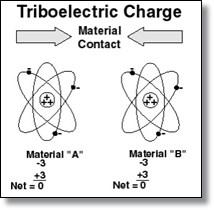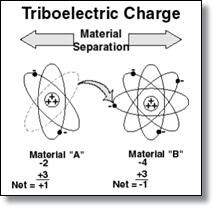| |
 |
|
 |
| |
Figure 1 The Triboelectric Charge. |
Figure 2 The Triboelectric Charge - Separation |
| |
| Creating electrostatic charge by contact and separation of materials is known as
"triboelectric charging." It involves the transfer of electrons between materials. The
atoms of a material with no static charge have an equal number of positive (+) protons
in their nucleus , negative (-) electrons orbiting the nucleus. In Figure 1, Material
"A" consists of atoms with equal numbers of protons and electrons. Material B also
consists of atoms with equal (though perhaps different) numbers of protons and
electrons. Both materials are electrically neutral. When the two materials are placed in contact and then separated, negatively charged
electrons are transferred from the surface of one material to the surface of the other
material. Which material loses electrons and which gains electrons will depend on the
nature of the two materials. The material that loses electrons becomes positively
charged, while the material that gains electrons is negatively charged. This is shown
in Figure 2.Static electricity is measured in coulombs. The charge "q" on an object is determined
by the product of the capacitance of the object "C" and the voltage potential on the
object (V):
q=CV
Commonly, however, we speak of the electrostatic potential on an object, which is
expressed as voltage.
This process of material contact, electron transfer and separation is really a more
complex mechanism than described here. The amount of charge created by
triboelectric generation is affected by the area of contact, the speed of separation,
relative humidity, and other factors. Once the charge is created on a material, it
becomes an "electrostatic" charge (if it remains on the material). This charge may be
transferred from the material, creating an electrostatic discharge, or ESD, event.
Additional factors such as the resistance of the actual discharge circuit and the contact resistance at the interface between contacting surfaces also affect the actual charge
that can cause damage. |
|
| An electrostatic charge also may be created on a material in other ways such as by induction,
ion |
| bombardment, or contact with another charged object. However, triboelectric charging is
the most common. |
| |
| How Material Characteristics Affect Static Charge |
| Triboelectric Series |
| When two materials contact and separate, the polarity and magnitude of the charge are
indicated by the materials' positions in the triboelectric series. The triboelectric series tables
show how charges are generated on various materials. When two materials contact and
separate, the one nearer the top of the series takes on a positive charge, the other a negative
charge. Materials further apart on the table typically generate a higher charge than ones
closer together. These tables, however, should only be used as a general guide because
there are many variables involved that cannot be controlled well enough to ensure
repeatability. A typical triboelectric series is shown in Table 3. |
|



